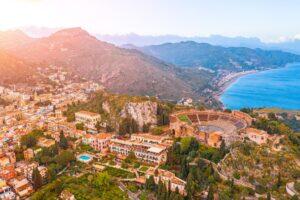Fodor's Expert Review Valle dei Templi
The temples of Agrigento, a UNESCO World Heritage site, are considered to be some of the finest and best-preserved Greek temples in the world. Whether you first come upon the valley in the early morning light, bathed by golden floodlights after sunset, or in January and February when the valley is awash in the fragrant blossoms of thousands of almond trees, it's easy to see why Akragas (Agrigento's Greek name) was celebrated by the poet Pindar as "the most beautiful city built by mortals." The temples were originally erected as a showpiece to flaunt the Greek victory over Carthage, and they have since withstood a later sack by the Carthaginians, mishandling by the Romans, and neglect by Christians and Muslims.
Although getting to, from, and around the dusty ruins of the Valle dei Templi is pretty easy, this important archaeological zone still deserves several hours. The temples are a bit spread out, but the valley is all completely walkable and usually toured... READ MORE
The temples of Agrigento, a UNESCO World Heritage site, are considered to be some of the finest and best-preserved Greek temples in the world. Whether you first come upon the valley in the early morning light, bathed by golden floodlights after sunset, or in January and February when the valley is awash in the fragrant blossoms of thousands of almond trees, it's easy to see why Akragas (Agrigento's Greek name) was celebrated by the poet Pindar as "the most beautiful city built by mortals." The temples were originally erected as a showpiece to flaunt the Greek victory over Carthage, and they have since withstood a later sack by the Carthaginians, mishandling by the Romans, and neglect by Christians and Muslims.
Although getting to, from, and around the dusty ruins of the Valle dei Templi is pretty easy, this important archaeological zone still deserves several hours. The temples are a bit spread out, but the valley is all completely walkable and usually toured on foot. However, since there's only one hotel (Villa Athena) that's close enough to walk to the ruins, you'll most likely have to drive to reach the site. The best place to park is at the entrance to the temple area. The site, which opens at 8:30 am, is divided into western and eastern sections, linked by a bridge. The best way to see them both is to park at the Temple of Juno entrance and walk downhill through the eastern zone, across the footbridge into the western zone, and then return back uphill, so that you see everything again but from a different angle and in a different light. The best time to go is a couple of hours before sunset, although if you are in Agrigento in high summer you might want to consider a night visit; the gates open a short while before sunset, with the temples floodlit as night falls.
You'll want to spend time seeing the eight pillars of the Tempio di Ercole (Temple of Hercules) that make up Agrigento's oldest temple complex, dating from the 6th century BC. The Tempio di Giunone (Temple of Juno) at the top of the hill is perhaps the most beautiful of all the temples, partly in ruins and commanding an exquisite view of the valley (especially at sunset). The low wall of mighty stone blocks in front of it was an altar on which animals were sacrificed as an offering to the goddess. Next down the hill is the almost perfectly complete Tempio della Concordia (Temple of Concord), perhaps the best-preserved Greek temple currently in existence, thanks to having been converted into a Christian church in the 6th century, and restored back to being a temple in the 18th century. Below it is the valley’s oldest surviving temple, the Temple of Hercules, with nine of its original 38 columns standing, the rest tumbled around like a child’s upended bag of building bricks.
Continuing over the pedestrian bridge, you reach the Tempio di Giove (Temple of Jupiter). Meant to be the largest temple in the complex, it was never completed, but it would have occupied approximately the site of a soccer field. It was an unusual temple, with half columns backing into a continuous wall, and 25-foot-high telamon, or male figures, inserted in the gaps in between. A couple of the telamon have been roughly reassembled horizontally on the ground near the temple. Beyond is the so-called Temple of Castor and Pollux, prettily picturesque, but actually a folly created in the 19th century from various columns and architectural fragments.
READ LESS








